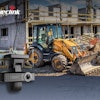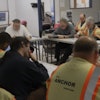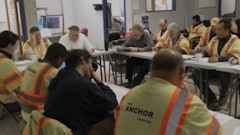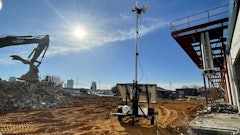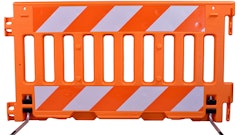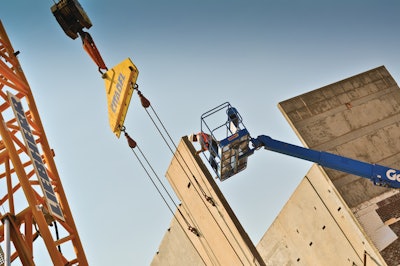
A massive concrete wall panel is being lifted from its horizontal position, where it was formed on a concrete slab, to a vertical orientation forming the perimeter of a new building. A large mobile crane applies the force while construction workers help orchestrate and control the fine-tuning of the panel as it moves through the air. This is the common scene to produce millions of square feet on construction projects around the world employing tilt-up concrete building envelopes, a process with more than six decades of history.
A team consisting of an owner, perhaps a developer, an architect, engineer and general contractor have worked hard to define a project with the optimum structural performance. This building is both resilient and highly energy efficient as well as making a striking and perhaps iconic statement of the owner’s goal with its aesthetics. The delivery of this program statement now turns to the talented team of craftspeople brought in with the expertise to achieve the final product. In an orchestrated fashion, the site is transformed into an array of activity across a broad horizontal landscape and seemingly little progresses until one day, a couple of weeks or more into the start, a building takes shape. Panels, massive and heavy with irregular geometry and patterns, have appeared from what was only the day before a flat site.
Unless you are present during the moments when these massive panels move into their designed positions, you might at first be concerned for the safety of those involved in erecting such concrete wall panels with large mobile cranes. While both reality and history note that tilt-up construction is an inherently safe method of construction, like all forms of construction, safety can always be greater. With this mindset, the Tilt-Up Concrete Association (TCA) has developed three new synergistic resources aimed at improving and communicating the safety of tilt-up construction. The revised TCA Safety Guideline for Tilt-Up Concrete Construction, the recently introduced TCA Company Certification Program, and the new TCA Erection and Rigging Training Program are now available to the industry. These resources and programs have been produced through the collaborative spirit of the industry’s leading contractors, committed to the continued improvement of both their own companies as well as the industry at large.
TCA Safety Guideline for Tilt-Up Concrete Construction
A product of the TCA’s Safety Committee, led by Barclay Gebel of Concrete Strategies in St. Louis, Mo., the new Safety Guideline expands the concepts of safety programming, risk management and OSHA regulation implementation for tilt-up construction professionals.
“We were looking at documents developed during the middle of the last decade,” states Gebel. “We found that while much of the data was as effective and meaningful today as it was then, a whole lot more could be done to further stress the caution and preparation professional tilt-up contractors must have on their project sites. Our committee made the decision to overhaul the guidelines and strengthen the ability for them to be implemented effectively and routinely on project sites in any market.”
Gebel and the committee maintained the basic principles of the construction process to remain as true today as when it came into popularity during the mid-1950s. Since the floor slab is cast first as it is the primary casting surface for the wall panels, a solid dry work area is created for the building trades. In addition, constructing the primary building framework and structural elements on the ground eliminates the need for scaffolding, further increasing worker safety.
“Overall, tilt-up construction is recognized as a reliable and safe building method,” states Jim Baty, Technical Director for the TCA. “However, all construction methods require good planning, a solid safety program and regular review to make sure they represent the most effective means of protecting the workforce and the environment.”
Tilt-up, as a method of construction, encourages crews to take advantage of the benefits of speed and economy inherent in the site-cast tilt-up process. However, for this to be maximized and effective, safety programs and guidelines must be planned and enforced. A comprehensive safety program goes well beyond what to do and not do in the field; it must begin with the preparation in the office before any field implementation is started. The new TCA guidelines provide a recommended safety program that should be followed by all tilt-up erection contractors. The program includes checks and guidelines for pre-lift, during lift, and after lift.
“The key for a safety program in a tilt-up firm is a site-specific safety plan,” states Gebel. “A site-specific safety plan for each project should include the sequence of tilt-up activity. What panels are you setting first? Which will be difficult picks? The safety plan should cover crane selection and placement. These are some of the highlights we made to the new guideline document.”
TCA Erection and Rigging Training Program
The new TCA Safety Guideline provides the base for another new development, the TCA’s Erection and Rigging Training Program, which has also been produced by the TCA Safety Committee. The program, which will be offered for the first time at the TCA Annual Convention in Houston, Texas, this fall, presents issues specific to the rigging and lifting of tilt-up panels.
The Occupation Safety and Health Association (OSHA) requires crane operations to involve qualified persons for rigging and signaling the certified crane operator. In an effort to further the industry preparedness and assuredness of this requirement, the TCA Safety Committee has established itself as a third party Qualified Evaluator for participants in the program. During the program delivery, demonstrations of the most common rigging equipment and connections are made. Safe and unsafe conditions are addressed as well as inspection points for the required equipment. Additionally, attendees to the program are given the signals essential to the lift operation and unified to the responsibility for hand signal communication as well as the proper positions for maintaining line of site. Attendees will also learn the essential activities and restrictions for all persons on the site during a lift, ensuring that no worker is out of position or located in an unsafe or unprotected situation.
“The TCA safety guideline provides the background and documented support for continued commitment to safety on tilt-up sites,” states Baty. “However, in order to more fully prepare industry participants to meet OSHA’s regulations and more importantly, protect their workforce, it was essential for this committee to set in motion this training program and be able to communicate the necessity of a plan to both our members and the industry at large.”
During the program, attendees will also be equipped to develop a quality tilt-up safety plan. This plan has several essential components including:
- Assessment of site conditions and planning
- Review of panel and building design against existing preparation
- Description of the special procedures required for hazardous non-routine tasks
- Bracing manual should be obtained
- Description of panel casting and erection activities and procedures
- Direction to obtain the erection subcontractor and crew experience
- Direct training essential for all members of the crew
- Review of crane capacity and mobility
- Agenda and schedule for safety meetings
- Schedule for inspections of rigging equipment and crane
- Review of fall protection and hazard training
- Plan for lifting and maneuvering panels and crane positioning
- Schedule for inspections of bracing equipment and removal timing
Staying Safe — A Quality Certified Tilt-Up Company
Following a quality safety program is an essential part of a tilt-up panel erection. It is also a requirement for the TCA’s new Certified Tilt-Up Company program. Produced through years of expertise in tilt-up construction, this collaborative effort has established a new level of quality assurance to the market for the tilt-up contractor.
The goal of the TCA Company Certification Program is to provide owners, specifiers and designers with a method for assuring the experience, quality and performance of tilt-up concrete contractors. The program will certify that companies who manage the tilt-up construction process have met the criteria established for evaluation. The criteria includes analysis of company policies, procedures and ability to consistently deliver a quality product and that they hire trained, certified and qualified personnel in all aspects of the tilt-up construction process.
The emphasis of the program is on quality control and quality assurance, but safety, experience, current activity, adherence to specifications and owner verification of performance are part of the evaluation criteria. An on-site review of company documents is performed to confirm and verify the information presented. Companies experience, performance, and adherence to the programs requirements are reviewed annually.
Safety is not an area where one contractor wants to one-up another. If one contractor has an accident, it has ramifications for the entire tilt-up industry, affecting the overall use of tilt-up. Likewise, the attention to quality and performance is not just for one company to focus on but rather a goal for an entire industry. The TCA, as the global authority for the tilt-up industry, is putting this mentality to work through the cooperative spirit of the leading tilt-up contractors across the United States.


